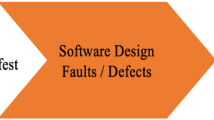Abstract
A management model for explaining software errors is developed and estimated. The model is used to analyze two years of error log data at a commercial site. The focus is on identifying managerially controllable factors which affect software reliability. At the research site, application systems which (1) underwent frequent modification; (2) were maintained by programmers with low levels of application experience; (3) had high reliability requirements, and (4) had high levels of static complexity all showed particularly high error rates, other things being equal. It is suggested that that managers can make quantified judgements about the degree to which they wish to reduce error rates by implementing a number of procedures, including enforcing release control, assigning more experienced maintenance programmers, and establishing and enforcing complexity metric standards.
Similar content being viewed by others
References
A.J. Albrecht and J. Gaffney, Software function, source lines of code, and development effort prediction: A software science validation, IEEE Transactions on Software Engineering SE-9(6) (1983) 639-648.
R.D. Banker, S.M. Datar and C.F. Kemerer, Factors affecting software maintenance productivity: An exploratory study, in: Proceedings of the 8th International Conference on Information Systems, Pittsburgh, PA (1987) pp. 160-175.
R.D. Banker, S.M. Datar and C.F. Kemerer, A model to evaluate variables impacting productivity on software maintenance projects, Management Science 37(1) (1991) 1-18.
R.D. Banker, S.M. Datar, C.F. Kemerer and D. Zweig, Software complexity and software maintenance costs, Communications of the ACM 36(11) (1993) 81-94.
R.D. Banker, S.M. Datar and D. Zweig, Software complexity and maintainability, in: International Conference on Information Systems (Boston, MA, 1989) pp. 247-255.
R.D. Banker, S.M. Datar and D. Zweig, Software complexity metrics: An empirical study, working paper, University of Minnesota (1991).
K.A. Bannick, Breakdown of software expenditures in the Department of Defense, United States, and World, unpublished Masters thesis, Naval Postgraduate School (1991).
V.R. Basili and B. Perricone, Software errors and complexity: An empirical investigation, Communications of the ACM 27(1) (1984) 42-52.
D.A. Belsley, E. Kuh and R. E. Welsch, Regression Diagnostics (Wiley, New York, NY, 1980).
B.A. Benander, N. Gorla and A.C. Benander, An empirical study of the use of the GOTO statement, Journal of Systems and Software 11(3) (1990) 217-223.
B.W. Boehm, Software engineering economics, IEEE Transactions on Software Engineering SE-10(1) (1984) 10-21.
D.N. Card and W.W. Agresti, Measuring software design complexity, Journal of Systems and Software 8(3) (1988) 185-197.
C.K.S. Chong Hok Yuen, An empirical approach to the study of errors in large software under maintenance, in: 2nd IEEE Conference on Software Maintenance (1985) pp. 96-105.
B.S. Curtis, E. Sheppard, J.B. Kruesi-Bailey and D. Boehm-Davis, Experimental evaluation of software documentation formats, Journal of Systems and Software 9(2) (1989) 167-207.
W.K. Ehrlich and T.J. Emerson, Modelling software failures and reliability growth during system testing, in: Proceedings of the 9th International Conference on Software Engineering (1987) pp. 72-82.
N.E. Fenton, Software Metrics, A Rigorous Approach (Chapman & Hall, New York, 1991).
J. Gallant, Survey finds maintenance problem still escalating, Computerworld 20 (January 1986).
W.H. Greene, Econometric Analysis, 2nd edn. (Macmillan Publishing, New York, NY, 1993).
L.L. Gremillion, Determinants of program repair maintenance requirements, Communications of the ACM 27(8) (1984) 826-832.
S. Henry and D. Kafura, Software structure metrics based on information flow, IEEE Transactions on Software Engineering SE-7 (September 1981) 510-518.
W.S. Humphrey, Characterizing the software process: A maturity framework, IEEE Software 5(3) (1988) 73-79.
C.F. Kemerer, Measurement of software development productivity, unpublished CarnegieMellon University Ph.D. thesis (1987).
C.F. Kemerer, Empirical research on software complexity and software maintenance, Annals of Software Engineering 1(1) (August 1995).
W. Kremer, Birth-death and bug counting, IEEE Transactions on Reliability 32(1) (April 1983) 37-47.
B.P. Lientz, E.B. Swanson and G.E. Tompkins, Characteristics of application software maintenance, Communications of the ACM 21(6) (1978) 466-471.
R. Lind and K. Vairavan, An experimental investigation of software metrics and their relationship to software development effort, IEEE Transactions on Software Engineering 15(5) (1989) 649-653.
R. Moawad, Comparison of concurrent software reliability models, in: Proceedings of the 7th International Conference on Software Engineering (1984) pp. 222-229.
K.H. Moller and D.J. Paulish, Software Metrics (Chapman & Hall, London, 1993).
J. Musa, A. Iannino and K. Okumoto, Software Reliability (McGraw-Hill, New York, NY, 1987).
J.D. Musa and W.W. Everett, Software-reliability engineering: Technology for the 1990s, IEEE Software (November 1990) 36-43.
M. Ohba and X.M. Chou, Does imperfect debugging affect software reliability growth? in: Proceedings of the 11th International Conference on Software Engineering (1989) pp. 237-244.
H. Schaefer, Metrics for optimal maintenance management, in: Proceedings of the Conference on Software Maintenance (1985) pp. 114-119.
V.Y. Shen, T.-J. Yu, S.M. Thebaut and L.R. Paulsen, Identifying error-prone software - An empirical study, IEEE Transactions on Software Engineering SE-11(4) (1985) 317-323.
M.L. Shooman, Software reliability: A historical perspective, IEEE Transactions on Reliability 33(1) (April 1984) 48-55.
H. Zuse, Software Complexity: Measures and Methods (Walter de Grutyer, New York, 1991).
D. Zweig, Software complexity and maintainability, unpublished Doctoral dissertation thesis, Carnegie Mellon University (1989).
Author information
Authors and Affiliations
Rights and permissions
About this article
Cite this article
Banker, R.D., Datar, S.M., Kemerer, C.F. et al. Software Errors and Software Maintenance Management. Information Technology and Management 3, 25–41 (2002). https://doi.org/10.1023/A:1013156608583
Issue Date:
DOI: https://doi.org/10.1023/A:1013156608583




